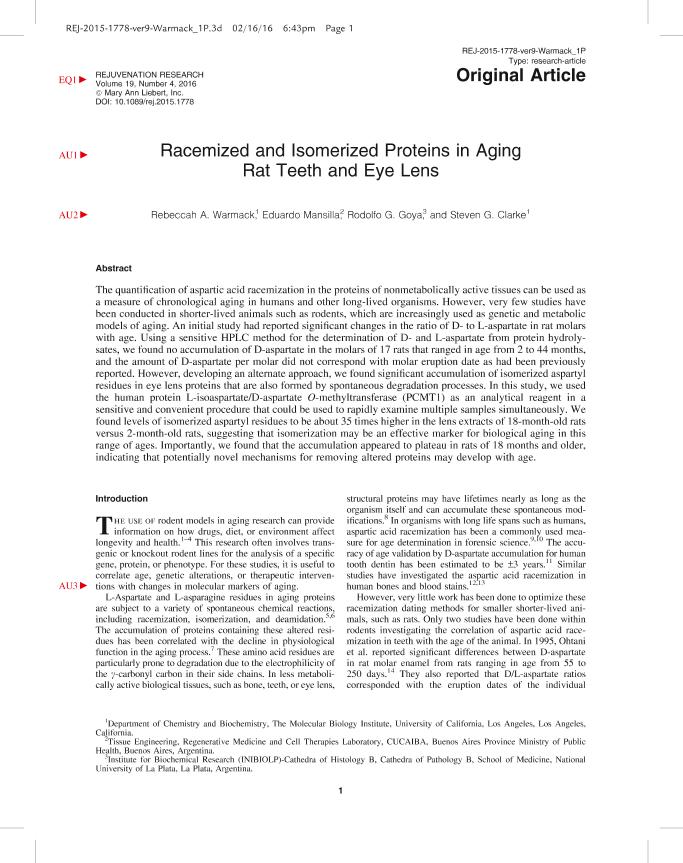Mostrar el registro sencillo del ítem
dc.contributor.author
Warmack, Rebeccah A.
dc.contributor.author
Mansilla, Eduardo
dc.contributor.author
Goya, Rodolfo Gustavo

dc.contributor.author
Clarke, Steven G.
dc.date.available
2018-06-15T17:20:45Z
dc.date.issued
2016-08
dc.identifier.citation
Warmack, Rebeccah A.; Mansilla, Eduardo; Goya, Rodolfo Gustavo; Clarke, Steven G.; Racemized and Isomerized Proteins in Aging Rat Teeth and Eye Lens; Mary Ann Liebert; Rejuvenation Research; 19; 4; 8-2016; 309-317
dc.identifier.issn
1549-1684
dc.identifier.uri
http://hdl.handle.net/11336/48800
dc.description.abstract
The quantification of aspartic acid racemization in the proteins of nonmetabolically active tissues can be used as a measure of chronological aging in humans and other long-lived organisms. However, very few studies have been conducted in shorter-lived animals such as rodents, which are increasingly used as genetic and metabolic models of aging. An initial study had reported significant changes in the ratio of d- to l-aspartate in rat molars with age. Using a sensitive HPLC method for the determination of d- and l-aspartate from protein hydrolysates, we found no accumulation of d-aspartate in the molars of 17 rats that ranged in age from 2 to 44 months, and the amount of d-aspartate per molar did not correspond with molar eruption date as had been previously reported. However, developing an alternate approach, we found significant accumulation of isomerized aspartyl residues in eye lens proteins that are also formed by spontaneous degradation processes. In this study, we used the human protein l-isoaspartate/d-aspartate O-methyltransferase (PCMT1) as an analytical reagent in a sensitive and convenient procedure that could be used to rapidly examine multiple samples simultaneously. We found levels of isomerized aspartyl residues to be about 35 times higher in the lens extracts of 18-month-old rats versus 2-month-old rats, suggesting that isomerization may be an effective marker for biological aging in this range of ages. Importantly, we found that the accumulation appeared to plateau in rats of 18 months and older, indicating that potentially novel mechanisms for removing altered proteins may develop with age.
dc.format
application/pdf
dc.language.iso
eng
dc.publisher
Mary Ann Liebert

dc.rights
info:eu-repo/semantics/openAccess
dc.rights.uri
https://creativecommons.org/licenses/by-nc-sa/2.5/ar/
dc.subject
Recemization
dc.subject
Rat Teeth
dc.subject
Eye Lens
dc.subject
Isomerized Proteins
dc.subject.classification
Otras Ciencias Químicas

dc.subject.classification
Ciencias Químicas

dc.subject.classification
CIENCIAS NATURALES Y EXACTAS

dc.title
Racemized and Isomerized Proteins in Aging Rat Teeth and Eye Lens
dc.type
info:eu-repo/semantics/article
dc.type
info:ar-repo/semantics/artículo
dc.type
info:eu-repo/semantics/publishedVersion
dc.date.updated
2018-06-14T19:05:58Z
dc.journal.volume
19
dc.journal.number
4
dc.journal.pagination
309-317
dc.journal.pais
Estados Unidos

dc.description.fil
Fil: Warmack, Rebeccah A.. University of California at Los Angeles; Estados Unidos
dc.description.fil
Fil: Mansilla, Eduardo. Universidad de Buenos Aires. Facultad de Medicina; Argentina
dc.description.fil
Fil: Goya, Rodolfo Gustavo. Consejo Nacional de Investigaciones Científicas y Técnicas. Centro Científico Tecnológico Conicet - La Plata. Instituto de Investigaciones Bioquímicas de La Plata ; Argentina
dc.description.fil
Fil: Clarke, Steven G.. University of California at Los Angeles; Estados Unidos
dc.journal.title
Rejuvenation Research

dc.relation.alternativeid
info:eu-repo/semantics/altIdentifier/doi/http://dx.doi.org/10.1089/rej.2015.1778
dc.relation.alternativeid
info:eu-repo/semantics/altIdentifier/url/https://www.liebertpub.com/doi/10.1089/rej.2015.1778
Archivos asociados
